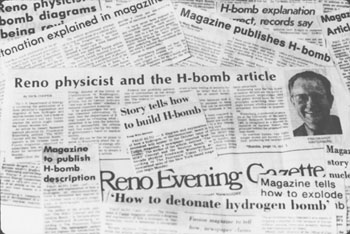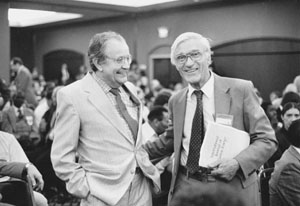 |
|
|
|
INTERVIEW WITH PROF. FRIEDWARDT WINTERBERG
A Revolutionary Concept for Fusion Energy
(From Fall 2003 21st Century)
Friedwardt Winterberg, Professor of Physics at the University of Nevada at Reno, was at the center of public controversy, when his book, The Physical Principles of Thermonuclear Devices was published by the Fusion Energy Foundation in 1981. In an effort to declassify information needed by scientists attempting to develop nuclear fusion as a civilian energy source, Dr. Winterberg revealed there certain essential principles behind the hydrogen bomb, known already to the United States’s enemies—but not to its own scientists.
Nuclear fusion is the energy source that powers the stars, including our Sun, and is thus the source for all life on Earth. Until now, thermonuclear fusion at significant power levels has been accomplished only in the H-bomb, whose name derives from the fact the the fuel is hydrogen, more specifically, heavy isotopes of hydrogen, known as deuterium and tritium. A practical means of producing controllable thermonuclear fusion for civilian energy production could revolutionize our society.
Dr. Winterberg was interviewed in July 2003 by Ralf Schauerhammer, an editor of the German-language Fusion magazine and co-author of The Holes in the Ozone Scare: The Scientific Evidence That the Sky Isn’t Falling.
Question: The German-language scientific journal Feitseitschrift für Naturforschung just published your article, which contains a new idea for the realization of energy production by thermonuclear fusion.1 Simply stated, it would seem that the civilian use of nuclear fusion could be achieved if we could produce tiny H-bombs, small enough that we could control their energy-output.
Yes, one speaks of “low-yield, high-gain” assemblies producing this type of microexplosions: “Low-yield,” because they have to produce an amount of energy low enough to be handled technically; “high-gain,” because the ignition energy to trigger the microexplosion must be as small as possible in relation to the achieved energy-output. This is important to achieve high efficiency of the fusion power reactor. In thermonuclear microexplosions a high gain can be achieved using a thermonuclear detonation wave, ignited from a “hot spot” in the center of the fuel pellet.
Question: One speaks of “inertial” fusion, because the detonation wave moves faster through the fuel than the fuel can be blown apart by the explosion. A different concept is to hold the fuel together and thermally insulate it with the aid of strong magnetic fields.
In the absence of a magnetic field, the fusion fuel requires precompression to 1,000 times solid density. A hot spot is created in the center by a convergent shock wave,2 or by a pulsed ultra-intense laser beam,3 the so-called “fast ignitor” concept.
Question: Didn’t you work out ideas of how to produce such microexplosions in very simple ways many years ago?
Already 35 years ago, for example, I had shown that the ignition of a thermonuclear microexplosion should be possible by the bombardment of a small, solid deuterium-tritium target with an intense relativistic electron beam of 100 MA current at 10 MV voltage drawn from a large Marx generator.4 It was the first proposal to use a Marx generator in fusion research.
|
|
|
|
|
|
|
|
SCHEMATIC OF DEVICE FOR ACHIEVING
HIGH-GAIN FUSION MICROEXPLOSIONS
A small, conically shaped target of deuterium-tritium fuel is placed at the juncture of two magnetically insulated transmission cables. A high voltage and relatively low current in the cable at left heats the tip of the cone to thermonuclear temperatures. A high current and relatively low voltage in the cable at the right generates a magnetic field pressure (marked H in the diagram), which contains the deuterium-tritium, and causes a shock wave to move to the right, up the fuel cone, igniting the rest of the fuel without the need for any more confinement.
|
|
|
|
|
|
|
Question: What is a Marx generator?
It is a pulse generator, first described by Erwin Marx in 1924. A number of capacitors are charged in parallel, and discharged in series, which produces a pulse of very high voltage.
Question: And your new idea builds upon your concept of 35 years ago?
In a certain way, but the crucial trick is that it uses two much smaller Marx generators, each one for a specific task. One, with a high current of 10 MA and a relatively lower voltage, is used for the compression and confinement; the other one, with a high voltage of 10 MV but a relatively lower current, is used for ignition.
Question: So this is the “fast ignitor” concept you mentioned?
Yes, but the difference is, that the existing “fast ignitor” uses very expensive lasers, which have, moreover, a very low efficiency. If my concept works experimentally, as I expect it to do, it could lead to devices which would be orders-of-magnitude cheaper than the fast ignitor concept currently being pursued by Lawrence Livermore National Lab.
Question: The present fast ignitor needs lasers in the power range of millions of millions of kilowatts, does it not?
The requirements are much larger than previously thought.
Question: But how is it possible to integrate the two discharges of the Marx generators?
It is probably best to look at the illustration I provided for use in the Zeitschrift für Naturforschung article [see figure]. The assembly consists of two nested, magnetically insulated transmission lines, with a small, conically shaped deuterium-tritium target placed at the focal point where the two lines come together. In the example presented in the article, a voltage of 10 MV and a current of 0.1 MA was chosen for the inner line, on the left side, For the outer line, on the right side, the voltage is 1 MV and the current 10 MA.
|
|
|
|
|
|

|
Some of the press flap generated by the 1981 publication of Professor Winterberg’s book, The Physical Principles of Thermonuclear Explosions, and its coverage in 21st Century’s predecessor magazine, Fusion.
|
|
|
|
|
|
|

|
The author (left) with plasma physicist Winston Bostick at a 1985 memorial conference for space scientist Krafft Ehricke, organized by Lyndon H. LaRouche, Jr., and his wife, Helga Zepp-LaRouche. Stuart Lewis/EIRNS
|
|
|
|
|
|
|
Question: How does the double-discharge work?
As you can see in the illustration, the return current conductor of the inner transmission line is connected at its smallest diameter to a cone of solid deuterium-tritium, which serves as the anode for this line. The intense relativistic electron beam emitted from the cathode tip of the inner line is focussed onto this cone, heating the cone’s tip to thermonuclear temperatures.
At the same time, a large electric current is discharged through the outer transmission line. This current must be large enough to generate a magnetic field pressure which can balance the pressure of the deuterium-tritium plasma at thermonuclear temperatures. If this is the case, and if at the same time, its energy compensates for the axial expansion losses of the hot plasma blown to the left from the tip of the cone, then a shock wave moves to the right into the fuel cone.
Question: And how does this shock wave come about?
The outer current confines the charged, fusion-reaction alpha particles within the cone, and the shock wave goes over into a thermonuclear detonation wave, supersonically moving down the cone. The wave starts in the small region near the vertex of the cone, and only there is magnetic confinement necessary, which is why a high gain is achieved.
Question: So, the left transmission line of high voltage generates a thermonuclear spark which is held together by the high current from the right side, allowing a thermonuclear detonation wave to come into being within the cone. And the size of the microexplosion is mainly determined by the size of the fuel cone?
While in an H-bomb the explosive power is in the order of 10 million tons of conventional explosives, the microexplosion here equals only 25 kg [55 pounds] of conventional explosives, and the ignition energy is the equivalent of only 25 grams.
Question: This is a gain factor of 1,000! And 25 kg of explosive is an amount of energy, that can be dealt with in a reactor vessel.
Notes
1. F. Winterberg, “Ignition of a Thermonuclear Detonation Wave in the Focus of Two Magnetically Insulated Transmission Lines,” Zeitschrift für Naturforschung, Vol. 58a, 197 (2003).
2. J. Nuckolls, L. Wood, G. Zimmerman, Nature, Vol. 239, p. 139 (1972).
3. M. Tabak et al. Physics of Plasma, Vol. 1, p. 1626 (1994).
4. F. Winterberg. Phys. Rev., Vol. 174, p. 212 (1968).
Selected Publications of Friedwardt Winterberg
“Attainment of High Plasma Pressures by a Large Number of Channelled Pinch Discharges Intersecting in One Point,” Phys. Plasmas, Vol. 3, p. 1 (1996).
“On a New Approach to the Thermonuclear Ignition Problem and Its Propulsion Potential,” Acta Astronautica, Vol. 36, p. 123 (1995).
“Derivation of Quantum Mechanics from the Boltzmann Equation for the Planck Aether,” International Journal of Theoretical Physics, Vol. 34, p. 2145 (1995).
|
|
|
|
|
|
|
|